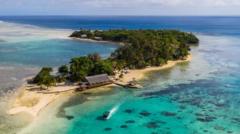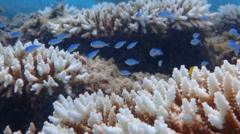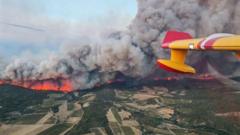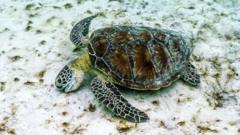**Scientists are celebrating the discovery of the world's largest coral, measuring 34 meters wide, in the Pacific Ocean, highlighting the need for coral protection amid climate change impacts.**
**Pacific Ocean Hosts Largest Coral Discovery**
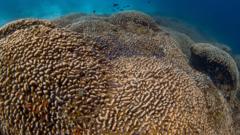
**Pacific Ocean Hosts Largest Coral Discovery**
**Record-Breaking Coral Found in Solomon Islands Stuns Researchers**
The largest coral ever recorded has been discovered in the southwest Pacific Ocean, astonishing scientists and local communities alike. This unique coral, which is actually a collection of interconnected tiny organisms forming one entity, could be over 300 years old, outpacing the size of a blue whale. The find was initiated by videographer Manu San Felix while working on a National Geographic expedition to assess climate change repercussions in remote Pacific regions.
Measuring an impressive 34 meters wide, 32 meters long, and 5.5 meters high, the coral is located in the Solomon Islands. "When I went diving where the map indicated a shipwreck, I was met with something extraordinary," stated San Felix, who later shouted for his son to join him in the water. He described the experience as akin to visiting a "cathedral underwater," expressing deep respect for this ancient organism that has withstood the test of centuries.
During the National Geographic dive, scientists documented the discovery using specialized underwater tape measures. The coral's health appears to be good, attributed to its location in deeper waters that may have shielded it from the detrimental impact of warming surface temperatures.
Although coral reefs are vital to ocean biodiversity and the livelihoods of approximately one billion people globally, they are under significant threat from climate change. Often deemed the "architects of the seas," corals play a crucial role in maintaining marine ecosystems.
The announcement of this discovery coincided with the UN climate conference COP29 held in Baku, Azerbaijan, where discussions focus on addressing climate change. Trevor Manemahaga, the climate minister for the Solomon Islands, expressed national pride in the find, emphasizing the significance of protecting their marine heritage for economic sustainability.
He remarked, "We rely heavily on marine resources for economic survival, making coral indispensable to our economy." Manemahaga reflected on the visible impacts of climate change, such as intensified cyclones and coastal erosion, highlighting the precarious position of small island nations.
At the conference, there were calls for increased funding from wealthier nations to help developing countries mitigate climate change effects. Increased financial support would enable the Solomon Islands to diversify employment opportunities and decrease reliance on industries like logging, which contributes to water pollution harming coral ecosystems.
Eric Brown, a coral scientist part of the National Geographic research team, noted the discovery as a "beacon of hope" amid degraded shallow reefs nearby. The coral species identified, Pavona clavus, serves as a habitat for various marine life, including shrimp and fish, and also acts as a valuable historical record for understanding past ocean conditions.
Recent reports indicate alarming figures: 44% of corals in warm waters face extinction risks. This figure has increased by a third since the last assessment in 2008, underscoring an urgent need for action regarding climate change and its effects on critical marine ecosystems.
Measuring an impressive 34 meters wide, 32 meters long, and 5.5 meters high, the coral is located in the Solomon Islands. "When I went diving where the map indicated a shipwreck, I was met with something extraordinary," stated San Felix, who later shouted for his son to join him in the water. He described the experience as akin to visiting a "cathedral underwater," expressing deep respect for this ancient organism that has withstood the test of centuries.
During the National Geographic dive, scientists documented the discovery using specialized underwater tape measures. The coral's health appears to be good, attributed to its location in deeper waters that may have shielded it from the detrimental impact of warming surface temperatures.
Although coral reefs are vital to ocean biodiversity and the livelihoods of approximately one billion people globally, they are under significant threat from climate change. Often deemed the "architects of the seas," corals play a crucial role in maintaining marine ecosystems.
The announcement of this discovery coincided with the UN climate conference COP29 held in Baku, Azerbaijan, where discussions focus on addressing climate change. Trevor Manemahaga, the climate minister for the Solomon Islands, expressed national pride in the find, emphasizing the significance of protecting their marine heritage for economic sustainability.
He remarked, "We rely heavily on marine resources for economic survival, making coral indispensable to our economy." Manemahaga reflected on the visible impacts of climate change, such as intensified cyclones and coastal erosion, highlighting the precarious position of small island nations.
At the conference, there were calls for increased funding from wealthier nations to help developing countries mitigate climate change effects. Increased financial support would enable the Solomon Islands to diversify employment opportunities and decrease reliance on industries like logging, which contributes to water pollution harming coral ecosystems.
Eric Brown, a coral scientist part of the National Geographic research team, noted the discovery as a "beacon of hope" amid degraded shallow reefs nearby. The coral species identified, Pavona clavus, serves as a habitat for various marine life, including shrimp and fish, and also acts as a valuable historical record for understanding past ocean conditions.
Recent reports indicate alarming figures: 44% of corals in warm waters face extinction risks. This figure has increased by a third since the last assessment in 2008, underscoring an urgent need for action regarding climate change and its effects on critical marine ecosystems.




